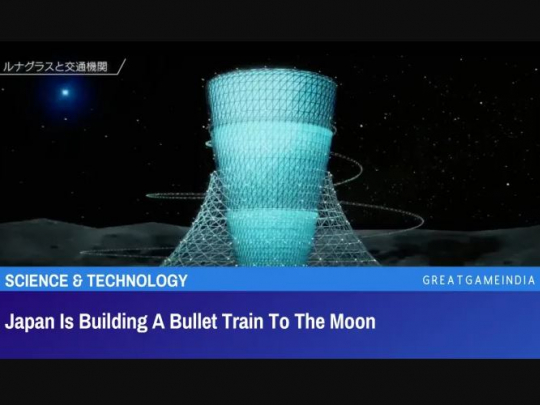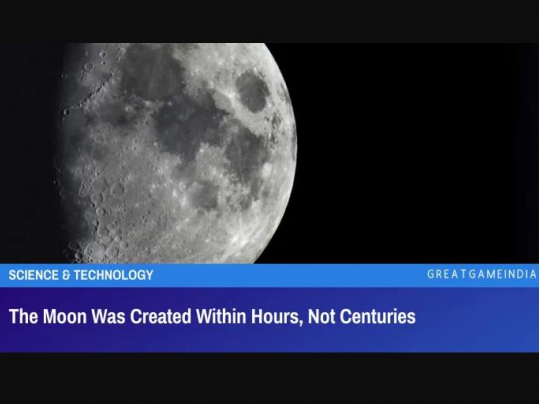Japan Is Building A Bullet Train To The Moon

In a recent video, Kyoto University and Kajima Construction in Japan revealed their plan to build a bullet train to the moon, which will be called Glass.
The team revealed its ambitious plans to create the “Glass” habitat living structure, which will replicate Earth’s gravity, terrain, and atmosphere, in a press conference last week. This will prevent the “weakening” of the human musculoskeletal system in zero and low gravity environments.
As the US restarts its moon missions, China begins exploring Mars, Russia and China are preparing a joint moon base, and humanity begin to live outside of Earth, the new space race is emerging as the pivotal event of our times. While our bodies and physical traits have evolved over millions of years, life outside the gravity of Earth and the atmosphere poses concerns.
The ‘Glass’ – Another Earth on Moon & Mars!
Human muscles, bones, and the entire exoskeletal skeleton may become too accustomed to the low gravity in space, losing their natural “strength” and “softening” over time.
Since its impacts have not yet been thoroughly researched, raising children in space is considerably riskier because there is a chance that they won’t be born healthy. Even if they succeed, they might not be able to walk independently when they arrive back on Earth. By the second half of the twenty-first century, the team predicts human migration to the Moon and Mars.
In order to create “The Glass,” a conical living structure with artificial gravity that includes public transportation, green areas, and water bodies similar to those found on Earth, Kyoto University and Kajima Construction are working together.
A large rotating cylindrical upright building with rivers, water, and park-like amenities for humans to live in while they are not outside the planet’s terrain was shown in their illustrated presentation at a press conference last week.
In essence, it is an inverted cone that rotates to provide a centrifugal pull that resembles the gravitational pull of the Earth. Researchers want to construct a simplified prototype version by 2050, which will stand around 1,300 feet tall and have a 328-foot radius. The Asahi Shimbun estimates that it will take around a century to construct and make use of the final version.
The habitat on the moon will be known as the “Lunaglass,” and the one on Mars will be known as the “Marsglass.” The “core biome complex,” which refers to a multidisciplinary field of geology, biology, botany, various physics, engineering, and climatology, will be fed with components from the Earth’s ecosystem and topography.
Some of the affects of spaceflight and lengthy life outside Earth on astronauts returning from the International Space Station (ISS) include decreasing bone density, muscle loss, and diminished eyesight. It explains the demanding workout and strength training regimens of astronauts that are frequently shown in videos.
Body fluids might build up in the upper part of the body as a result of the biochemical and neurological effects, frequently impairing eyesight. As a result, during the past fifty years, the field of outer space medicine has grown into a whole new subspecialty of medicine.
Interplanetary ‘Space Express’!
The group’s plans are the stuff of science fiction. In order to lessen the impacts of extended exposure to low gravity, they also foresee an interplanetary transportation system called the “Hexatrack” that maintains a gravity of 1G even during long-distance travel.
Hexacapsules are hexagon-shaped capsules with a prepared moving device at the center.
The Earth and Moon are connected by a small mini-capsule with a radius of 15 meters, and the Moon and Mars are connected by a huge capsule with a radius of 30 meters.
The huge capsule is built in a way that allows the outer frame to “float,” presumably using electromagnetic technology similar to that used in China’s and Germany’s Maglev trains.
The radial centre axis is used for people leaving each vehicle. Moon and Mars are moving at a constant 1G (radius of 30 meters, 5.5 rounds per minute).
The railroad’s Earth station will be known as the Terra Station, and a train traveling on a standard gauge track with six coaches will be known as the Space Express.
With rocket boosters attached to them, the leading and trailing cars will be able to accelerate and decelerate in space as well as escape the gravitational pull of each planet and stay outside of the atmosphere. Its wings spread when it moves over planets with atmospheres. It will function as a high-speed railway with gauge connecting the base cities on the moon to Mars.
While the United States and the United Arab Emirates are actively promoting the migration to Mars, Yosuke Yamashiki, the Director of the SIC Manned Cosmology Research Center and Graduate School of Advanced Integrated Studies at Kyoto University, says he wanted Japan to table a completely different, “original idea independently.”
“Through discussions over the past few years, these three pillars that we propose this time are core technologies that are not in the development plans of other countries and are indispensable for ensuring the realization of human space colonization in the future,” he added.
- Source : GreatGameIndia



















